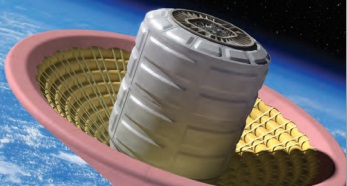Chapter: Fiber Optic Sensing, new invention technology, Research project papers,
Strain Sensing for Highly Elastic Materials

Strain Sensing for
Highly Elastic Materials
A research team at
Armstrong is developing a sensor that can measure strain on highly elastic
materials, such as inflatable wings, reentry vehicles, and airships. Conventional
foil strain gauges are inaccurate when used on highly elastic materials because
of localized stiffening due to the relatively high modulus of sensors and their
adhesive mechanisms, which reduces strain transfer to the sensing element. To
counteract these problems, the Armstrong team has adapted a strain measuring
device currently used in the medical field to diagnose endothelial dysfunction.
Work to date: Laboratory testing and
sensor calibration has been achieved during testing of eight 11- to
17-foot diameter tori from the Hypersonic Inflatable Aerodynamic Decelerator
(HIAD) vehicle. Under compressive loading, strain levels at buckling were
determined with the data generated from these sensors.
Looking ahead: The team will continue
to characterize and evaluate the sensor and flexible adhesive.
Benefits
Broader range of measurement:
Measures high strains
(over 100 percent)
More accurate: Works without
creating localized stiffening that could bias strain measurements
Applications
Gulfstream III test aircraft Inflatable wings
Reentry vehicles Airships
Fiber Optic Sensing
Armstrong's portfolio of Fiber Optic Sensing System (FOSS)
technologies offers unparalleled options for high-resolution sensing in
applications that require a unique combination of high-powered processing and
lightweight, flexible, and robust sensors. The system measures real-time
strain, which can be used to determine two-dimensional and three-dimensional
shape, temperature, liquid level, pressure, and loads, alone or in combination.
Initially developed to monitor aircraft structures in flight, the system's
capabilities open up myriad new applications for fiber optics-not just in
aerospace but also for civil structures, transportation, oil and gas, medical,
and many more industries.
The Armstrong approach employs fiber Bragg grating (FBG)
sensors, optical frequency domain reflectometry (OFDR) sensing, and
ultra-efficient algo-rithms (100 samples/second). Engineers are continually
seeking new ways of looking at information and determining what is important.
Armstrong's FOSS technologies focus on critical research needs. Whether it is
used to determine shape, stress, temperature, pressure, strength, operational
load, or liquid level, this technology offers ultra-fast, reliable
measurements.
Related Topics